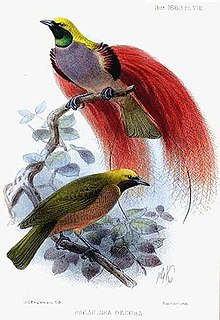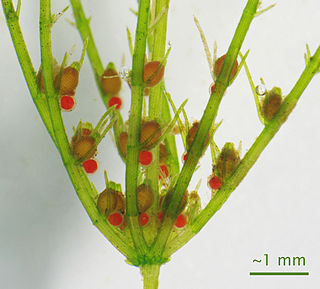
The clitoris is a female sex organ present in mammals, ostriches and a limited number of other animals. In humans, the visible portion - the glans - is at the front junction of the labia minora, above the opening of the urethra. Unlike the penis, the male homologue (equivalent) to the clitoris, it usually does not contain the distal portion of the urethra and is therefore not used for urination. The clitoris also usually lacks a reproductive function. While few animals urinate through the clitoris or use it reproductively, the spotted hyena, which has an especially large clitoris, urinates, mates, and gives birth via the organ. Some other mammals, such as lemurs and spider monkeys, also have a large clitoris.

Sexual selection is a mode of natural selection where members of one biological sex choose mates of the other sex to mate with, and compete with members of the same sex for access to members of the opposite sex. These two forms of selection mean that some individuals have better reproductive success than others within a population, either from being more attractive or preferring more attractive partners to produce offspring. For instance, in the breeding season, sexual selection in frogs occurs with the males first gathering at the water's edge and making their mating calls: croaking. The females then arrive and choose the males with the deepest croaks and best territories. In general, males benefit from frequent mating and monopolizing access to a group of fertile females. Females can have a limited number of offspring and maximize the return on the energy they invest in reproduction.

Organisms of many species are specialized into male and female varieties, each known as a sex. Sexual reproduction involves the combining and mixing of genetic traits: specialized cells known as gametes combine to form offspring that inherit traits from each parent. The gametes produced by an organism define its sex: males produce small gametes while females produce large gametes. Individual organisms which produce both male and female gametes are termed hermaphroditic. Gametes can be identical in form and function, but, in many cases, an asymmetry has evolved such that two different types of gametes (heterogametes) exist.

A sex organ is any part of an animal's body that is involved in sexual reproduction. The reproductive organs together constitute the reproductive system. The testis in the male, and the ovary in the female, are called the primary sex organs. The external sex organs – the genitals or genitalia, visible at birth in both sexes, and the internal sex organs are called the secondary sex organs.

The rotifers make up a phylum of microscopic and near-microscopic pseudocoelomate animals.

Female ejaculation is characterized as an expulsion of fluid from or near the vagina during or before an orgasm. It is also known colloquially as squirting or gushing, although these are considered to be different phenomena in some research publications.

In biology, mating is the pairing of either opposite-sex or hermaphroditic organisms, usually for the purposes of sexual reproduction. Some definitions limit the term to pairing between animals, while other definitions extend the term to mating in plants and fungi. Fertilization is the fusion of both sex cell or gamete. Copulation is the union of the sex organs of two sexually reproducing animals for insemination and subsequent internal fertilization. Mating may also lead to external fertilization, as seen in amphibians, fishes and plants. For the majority of species, mating is between two individuals of opposite sexes. However, for some hermaphroditic species, copulation is not required because the parent organism is capable of self-fertilization (autogamy); for example, banana slugs.
Sexual dysfunction is difficulty experienced by an individual or a couple during any stage of a normal sexual activity, including physical pleasure, desire, preference, arousal or orgasm. According to the DSM-5, sexual dysfunction requires a person to feel extreme distress and interpersonal strain for a minimum of six months. Sexual dysfunctions can have a profound impact on an individual's perceived quality of sexual life. The term sexual disorder may not only refer to physical sexual dysfunction, but to paraphilias as well; this is sometimes termed disorder of sexual preference.

The female reproductive system is made up of the internal and external sex organs that function in reproduction of new offspring. In the human the female reproductive system is immature at birth and develops to maturity at puberty to be able to produce gametes, and to carry a foetus to full term. The internal sex organs are the uterus, Fallopian tubes, and ovaries. The uterus or womb accommodates the embryo which develops into the foetus. The uterus also produces vaginal and uterine secretions which help the transit of sperm to the Fallopian tubes. The ovaries produce the ova. The external sex organs are also known as the genitals and these are the organs of the vulva including the labia, clitoris, and vaginal opening. The vagina is connected to the uterus at the cervix.

Sexual differentiation is the process of development of the differences between males and females from an undifferentiated zygote. As male and female individuals develop from zygotes into fetuses, into infants, children, adolescents, and eventually into adults, sex and gender differences at many levels develop: genes, chromosomes, gonads, hormones, anatomy, and psyche.
Body worship is any practice of physically revering a part of another person's body, and is usually done as a submissive act in the context of BDSM. Typical kinds of body worship include worship of muscles, the penis, the vagina, or the buttocks.

Animal sexual behaviour takes many different forms, including within the same species. Common mating or reproductively motivated systems include monogamy, polygyny, polyandry, polygamy and promiscuity. Other sexual behaviour may be reproductively motivated or non-reproductively motivated.

The male reproductive system consists of a number of sex organs that play a role in the process of human reproduction. These organs are located on the outside of the body and within the pelvis.

The human reproductive system usually involves internal fertilization by sexual intercourse. In this process, the male inserts his penis into the female's vagina and ejaculates semen, which contains sperm. A small proportion of the sperm pass through the cervix into the uterus, and then into the Fallopian tubes for fertilization of the ovum. Only one sperm is required to fertilize the ovum. Upon successful fertilization, the fertilized ovum, or zygote, travels out of the Fallopian tube and into the uterus, where it implants in the uterine wall. This marks the beginning of gestation, better known as pregnancy, which continues for around nine months as the foetus develops. When the foetus has developed to a certain point, pregnancy is concluded with childbirth, involving labor. During labor, the muscles of the uterus contract and the cervix dilates over the course of hours, and the baby passes out of the vagina. Human infants are nearly helpless and require high levels of parental care. Infants rely on their caregivers for comfort, cleanliness, and food. Food may be provided by breastfeeding or formula feeding.
Fish reproductive organs include testes and ovaries. In most species, gonads are paired organs of similar size, which can be partially or totally fused. There may also be a range of secondary organs that increase reproductive fitness. The genital papilla is a small, fleshy tube behind the anus in some fishes, from which the sperm or eggs are released; the sex of a fish often can be determined by the shape of its papilla.

Sexual conflict or sexual antagonism occurs when the two sexes have conflicting optimal fitness strategies concerning reproduction, particularly over the mode and frequency of mating, potentially leading to an evolutionary arms race between males and females. In one example, males may benefit from multiple matings, while multiple matings may harm or endanger females, due to the anatomical differences of that species. The development of an evolutionary arms race can also be seen in the chase-away sexual selection model, which places inter-sexual conflicts in the context of secondary sexual characteristic evolution, sensory exploitation, and female resistance. According to chase-away selection, continuous sexual conflict creates an environment in which mating frequency and male secondary sexual trait development are somewhat in step with the female's degree of resistance. It has primarily been studied in animals, though it can in principle apply to any sexually reproducing organism, such as plants and fungi. There is some evidence for sexual conflict in plants.

A man is a male human. The term man is usually reserved for an adult male, with the term boy being the usual term for a male child or adolescent. However, the term man is also sometimes used to identify a male human, regardless of age, as in phrases such as "men's basketball".

Tarantulas comprise a group of large and often hairy arachnids belonging to the Theraphosidae family of spiders, of which about 900 species have been identified. This article only describes members of the Theraphosidae, although some other members of the same infraorder (Mygalomorphae) are commonly referred to as "tarantulas". Some species have become popular in the exotic pet trade. New World species kept as pets have urticating hairs that can cause irritation to the skin and, in extreme cases, cause damage to eyes.
The reproductive system or genital system is a system of sex organs within an organism which work together for the purpose of sexual reproduction. Many non-living substances such as fluids, hormones, and pheromones are also important accessories to the reproductive system. Unlike most organ systems, the sexes of differentiated species often have significant differences. These differences allow for a combination of genetic material between two individuals, which allows for the possibility of greater genetic fitness of the offspring.

The external morphology of Lepidoptera is the physiological structure of the bodies of insects belonging to the order Lepidoptera, also known as butterflies and moths. Lepidoptera are distinguished from other orders by the presence of scales on the external parts of the body and appendages, especially the wings. Butterflies and moths vary in size from microlepidoptera only a few millimetres long, to a wingspan of many inches such as the Atlas moth. Comprising over 160,000 described species, the Lepidoptera possess variations of the basic body structure which has evolved to gain advantages in adaptation and distribution.
















